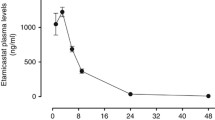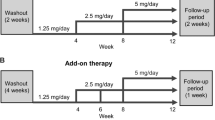Summary
The effect on urinary electrolyte excretion, renin release and plasma norepinephrine of single oral doses of 400 mg etozolin (E) and of 40 mg furosemide (F) were studied in hypertensive patients with normal (n=6) and impaired kidney function (n=6). E caused a marked saluresis up to 24 hours, showing its long duration of action. F, however, displayed a brief, brisk peak diuresis, followed by a rebound from the 4th to the 24th hours. The brisk peak diuresis induced by F was associated with pronounced release of renin, almost twice that induced by E. In chronic renal failure the renin release in relation to the magnitude of the diuresis was increased, i.e. the sensitivity of these patients to changes in water homeostasis was increased. E and F stimulated the sympathetic system to roughly the same extent. Patients with essential hypertension had higher plasma levels of norepinephrine than hypertensive patients with chronic renal failure. In addition, hypertensive patients with normal renal function (n=4) and varying degrees of renal impairment (n=11) were also given 400 mg daily for 2 weeks. Effects on blood pressure and electrolyte homeostasis were monitored, as well as the plasma kinetics of metabolite I, ozolinone. At the end of the 2 week treatment E had significantly lowered systolic (−12 mm Hg) and diastolic (−9 mm Hg) blood pressure, and had produced a significant loss of body weight, without altering plasma electrolytes or blood chemistry. There was no accumulation of the effective metabolite ozolinone under conditions of severe impairment of kidney function. It is concluded that E can effectively control high blood pressure in patients with normal and impaired kidney function. Its effective metabolite ozolinone did not accumulate in chronic renal failure.
Similar content being viewed by others
References
Beretta-Piccoli C, Weidmann P, De Chatel R, Hirsch D (1977) Beziehungen zwischen Blutdruck, Blutvolumen und Plasmarenin während Diuretikatherapie bei essentieller Hypertonie. Vergleich des Mineralocorticoid-Antagonisten Spironolacton mit dem „Schleifendiuretikum“ Mefrusid. Schweiz Med Wochenschr 107: 104–115
Dreifus LS, Duarte C, Kodama R, Moyer HJ (1960) The effect of thiazide diuretics on the abnormal kidney. Ann Intern Med 53: 1170–1179
Felix G (1978) Etozolin in der Therapie der Hypertension bei ambulanten Patienten. Therapiewoche 28: 3949–3957
Gerber JG (1981) Antihypertensive agents and diuretics. In: Anderson RJ, Schrier RW (eds) Clinical use of drugs in patients with kidney and liver disease. Saunders, London, pp 211–229
Gladigau V, Vollmer K-O (1977) Beschreibung des pharmakokinetischen Verhaltens von Etozolin und dessen Hauptmetaboliten. Arzneim-Forsch/Drug Res 27: 1786–1799
Greven J, Beckers M, Heidenreich O (1981) Interaktionen von stark wirksamen Diuretika mit der tubulären Sekretion von anionischen endogenen Substanzen und Arzneimitteln. In: Diuretika II, Krück F, Schrey A (Hrsg.) Universitätsdruckerei und Verlag Dr C Wolf und Sohn, München, p 221–231
Greven J, Beckers M, Defrain W, Maywald K, Heidenreich O (1980) Studies with the optically active isomers of the new diuretic drug ozolinone. II. Inhibition by d-ozolinone of furosemide induced diuresis. Pflügers Arch 384: 61–64
Greven J, Defrain W, Glaser K, Maywald K, Heidenreich O (1980) Studies with the optically active isomers of the new diuretic drug ozolinone. I. Differences in stereoselectivity of the renal target structures of ozolinone. Pflügers Arch 384: 57–60
Greven J, Heidenreich O (1977) Effect of etozolin on whole kidney function and fluid and electrolyte reabsorption in rat proximal convoluted tubules and loops of Henle. Arzneim-Forsch/Drug Res 27: 1755–1757
Greven J, Heidenreich O (1978) Effects of ozolinone, a diuretic active metabolite of etozolin, on renal function. 1. Clearance studies in dogs. Naunyn-Schmiedebergs Arch Pharmakol 304: 283–287
Haber E, Koerner T, Page LB, Kliman H, Purnode A (1969) Application of a radioimmunoassay for angiotensin I to the physiologic measurements of plasma renin activity in normal human subjects. J Clin Endocrinol 29: 1349–1355
Haslbeck M, Renner R, Kemmler W, Schneider B, Mehnert H (1979) Zur Frage der Beeinflussung des Kohlehydratstoffwechsels durch ein neues Saluretikum (Etozolin). Fortschr Med 97: 1825–1830
Heinzel G (1982) Salient points of various programs TOPFIT. In: Bozler G, van Rossum JM (eds) Pharmacokinetics during drug development: data analysis and evaluation techniques. G Fischer, Stuttgart New York, pp 207–208
Hengy H, Vollmer K-O, Gladigau V, Kölle E-U (1980) Assay of etozolin and its main metabolite, ozolinone, in plasma by high performance liquid chromatography. Arzneim-Forsch/Drug Res 30: 1788–1790
v. Hodenberg A, Vollmer K-O, Klemisch W, Liedtke B (1977) Metabolismus von Etozolin bei Ratte, Hund und Mensch. Arzneim-Forsch/Drug Res 27: 1776–1785
Keller E, Hoppe-Seyler G, Mumm R, Schollmeyer P (1981) Influence of hepatic cirrhosis and end-stage renal disease on pharmacokinetics and pharmacodynamics of furosemide. Eur J Clin Pharmacol 20: 27–33
Knauf H, Hasenfuß G, Schollmeyer P, Mutschler E (1980) Independence of etozolin elimination of kidney function. Single dose experiments in patients with renal insufficiency. Arzneim-Forsch/Drug Res 30: 1791–1793
Peuler J, Johnson G (1977) Simultaneous single isotope radioenzymatic assay of plasma norepinephrine, epinephrine and dopamine. Life Sci 21: 625–636
Satzinger G (1977) Struktur-Aktivitätsbetrachtungen zu Etozolin, einem neuartigen Diuretikum. Arzneim-Forsch/Drug Res 27: 1742–1745
Stone WJ, Walle T (1980) Massive propranolol metabolite retention during maintenance haemodialysis. Clin Pharmacol Ther 28: 449–455
Vollmer K-O, v Hodenberg A, Poisson A, Gladigau V, Hengy H (1977) Resorption, Verteilung, Metabolismus und Ausscheidung von 14C-Etozolin bei Ratte, Hund und Mensch. Arzneim-Forsch/Drug Res 27: 1767–1776
Weidmann P (1980) Recent pathogenetic aspects in essential hypertension and in hypertension associated with diabetes mellitus. Klin Wochenschr 58: 1071–1089
Windsheimer F (1978) Therapie der primären Hypertension mit einer Monosubstanz. Therapiewoche 28: 5771–5777
Author information
Authors and Affiliations
Rights and permissions
About this article
Cite this article
Knauf, H., Liebig, R., Schollmeyer, P. et al. Pharmacodynamics and kinetics of etozolin/ozolinone in hypertensive patients with normal and impaired kidney function. Eur J Clin Pharmacol 26, 687–693 (1984). https://doi.org/10.1007/BF00541926
Received:
Accepted:
Issue Date:
DOI: https://doi.org/10.1007/BF00541926




